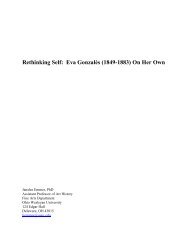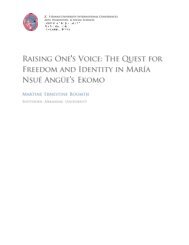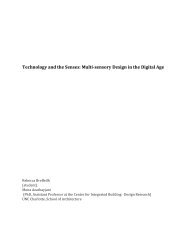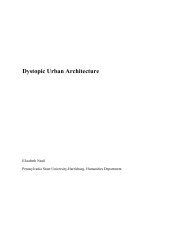2012 HUIC - Hawaii University International Conference on Arts and ...
2012 HUIC - Hawaii University International Conference on Arts and ...
2012 HUIC - Hawaii University International Conference on Arts and ...
You also want an ePaper? Increase the reach of your titles
YUMPU automatically turns print PDFs into web optimized ePapers that Google loves.
But even though dance is a form of moving, its functi<strong>on</strong> goes bey<strong>on</strong>d the simple<br />
movements humans rely <strong>on</strong> everyday. Dance is expressi<strong>on</strong>. Webster's dicti<strong>on</strong>ary defines<br />
dance as, “Moving rhythmically to music,” but it is so much more. Dance is a vehicle that<br />
has the power to unite mind, body, soul; it is a n<strong>on</strong>verbal means of communicating in the<br />
universal language, expressing abstract ideas <strong>and</strong> emoti<strong>on</strong>s by emitting an energy that can<br />
be recognized <strong>and</strong> felt by the affected observer. It has the power to transcend cultural<br />
boundaries <strong>and</strong> speak to people <strong>on</strong> a deep, spiritual level.<br />
The more subtle <strong>and</strong> complex comp<strong>on</strong>ents of dance are centering <strong>and</strong> breath.<br />
These highly emoti<strong>on</strong>al elements are what allow a dancer to be capable of authentic<br />
expressi<strong>on</strong>.<br />
Centering is related to the basic comp<strong>on</strong>ent of balance. In order to achieve a sense of<br />
balance, a dancer must engage the solar plexus <strong>and</strong> lower torso. This porti<strong>on</strong> of the body<br />
is where most of the body’s crucial organs are located. Focusing <strong>on</strong> this area gives a<br />
dancer a greater sense of strength <strong>and</strong> c<strong>on</strong>nectedness within his or her own body. This<br />
stability allows the dancer to bring forth a spiritual essence that can be displayed <strong>and</strong><br />
expressed with c<strong>on</strong>fidence. These deep feelings can be seen <strong>and</strong> felt by the audience.<br />
Dance is not the <strong>on</strong>ly practice that is aware of the power that comes from focusing <strong>on</strong><br />
<strong>on</strong>e’s center. Centering has also been used as a term in ancient philosophies <strong>and</strong> religious<br />
practices to define a pathway for realizing bliss <strong>and</strong> inner peace. Zen masters refer to it as<br />
a way to focus inward, while the Quakers used the term "centering down," to explain a<br />
state of focused attenti<strong>on</strong>, of attentive listening to <strong>on</strong>e’s inner voice. (Richards, 1989<br />
p.xx)<br />
Breathing <strong>and</strong> Breath are essential to all humans. Breath is life, we must breathe to live<br />
<strong>and</strong> move. More specifically, our muscles need oxygen in order to resp<strong>on</strong>d to the<br />
comm<strong>and</strong> of our brain. In dance, an awareness <strong>and</strong> c<strong>on</strong>trol over the breath allows the<br />
dancer to maintain a sense of rhythm. Most dances are synchr<strong>on</strong>ized to some form of<br />
music or sound. If the music is faster, the dancer must move faster <strong>and</strong> therefore breathe<br />
faster. If the music <strong>and</strong> dance is slow <strong>and</strong> el<strong>on</strong>gated, the dancer will be better able to<br />
perform if he or she focuses <strong>on</strong> taking deep <strong>and</strong> deliberately el<strong>on</strong>gated breaths. The<br />
dances of some cultures employ chanting, <strong>and</strong> these dances require <strong>and</strong> even deeper focus<br />
<strong>on</strong> the breathing patterns. But regardless of the type of dance, a dancer must be aware of<br />
breath to get oxygen to the part of the body producing the energy to move. It takes<br />
c<strong>on</strong>centrati<strong>on</strong> <strong>and</strong> practice to learn to breathe efficiently while moving, but <strong>on</strong>ce this<br />
element is mastered, a dancer is able to express a greater sense of grace <strong>and</strong> c<strong>on</strong>trol.<br />
The Essence <strong>and</strong> Origins of Dance<br />
When studying the history <strong>and</strong> development of dance, we must start at the beginning.<br />
Where <strong>and</strong> when did dance originate? The answer is simple: dance has existed for as l<strong>on</strong>g<br />
as mankind has. It is believed by many to be the first means of artistic expressi<strong>on</strong>,<br />
preceding even ancient forms of music <strong>and</strong> painting. In primitive societies, dance was<br />
both a social <strong>and</strong> ritualistic practice. Primitive men danced to celebrate every aspect of<br />
life. They danced to appease the Gods <strong>and</strong> give thanks to them, believing it would please







